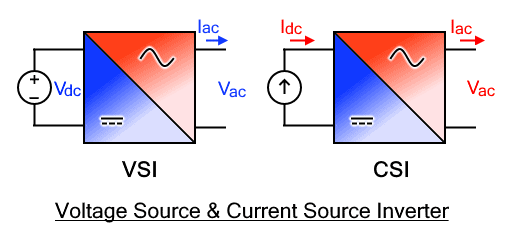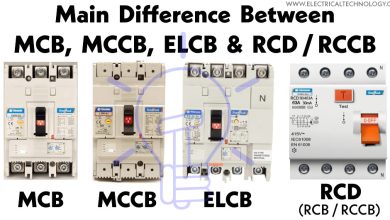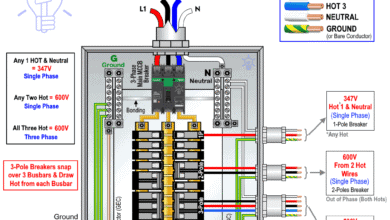Difference between Voltage Source Inverter & Current Source Inverter
What is the Difference between Voltage Source Inverter (VSI) and Current Source Inverter (CSI)?
The voltage source inverter (VSI) and the current source inverter (CSI) are two different types of inverters. Both of them are used for conversion from DC to AC. However, there are several differences between them as well as their applications.
Power electronics deal with different types of power converters. A power converter is a device or an electronic circuit that converts one form of electrical energy into a desirable form required by the electrical load. There are different types of power converters such as AC to AC, AC to DC, DC to AC and DC to DC.
An inverter is a type of power converter that converts from DC to AC. VSI and CSI are two types of inverters. Before going into the list of differences between VSI and CSI, let’s discuss their basics first.
What is Inverter?
An inverter is a device that is used to convert DC direct current into AC alternating current. The DC supplied has steady and fixed voltage. Whereas the output is AC whose amplitude and frequency can be adjusted. It is used for generating backup power from batteries or in an HVDC transmission system. It is also used in VFD (variable frequency drive) to have an adjustable frequency for motor control.
The inverter can only convert the electrical energy from one form to another. It cannot generate power on its own. It is made of a transistor such as MOSFET, IGBT, etc.
There are two types of the inverter; voltage source inverters VSI, and Current source inverters CSI. Both of them have unique advantages and disadvantages.
Voltage Source Inverter
VSI is a type of inverter whose input DC voltage is kept constant. The input DC source voltage does not fluctuate with changes in the load. Only input current changes which depend on the load. The source has negligible impedance. VSI is used in purely resistive or lightly inductive loads such as lighting systems, AC motors, heaters, etc.
A large capacitor is connected in parallel with the input DC source to maintain its voltage constant. Therefore the voltage does not vary, whereas the input DC current depends on the variation in load.
It is made of MOSFETs, and IGBT with a feedback diode called a freewheeling diode. The freewheeling diode is necessary for the reactive power.
- Related Post: Difference Between Online UPS and Offline UPS
Current Source Inverter
In CSI, the input DC current is kept constant. It is also called DC-link. The input DC current does not vary whereas the voltage does. The DC source has a very high impedance. It is used for highly inductive loads such as induction motors etc. Another advantage of CSI over VSI is that it is less prone to overloading and short-circuiting.
A large inductor is added in series with the DC source to create a constant current source. The inductor will not allow the current to change. Therefore in CSI, the current does not vary but the voltage does with the load.
CSI is made of thyristors without the requirement of a freewheeling diode.
Related Posts:
- Difference between Photodiode and Photoresistor (LDR)
- Difference Between Photodiode and Phototransistor
Main Differences Between Voltage Source and Current Source Inverter
The following table shows the comparisons between VSI and CSI.
| Voltage Source Inverter | Current Source Inverter |
| VSI is a type of inverter that has constant output voltage. | CSI is a type of inverter that has a constant output current. |
| It has a constant input DC voltage. | It has a constant input DC current. |
| It has a large capacitor connected in parallel with the input DC source. | It has a large inductor connected in series with the input DC source. |
| The input DC source has a negligible impedance | The input DC source has a large impedance. |
| BJT, MOSFET, IGBT, etc is used to design VSI | Thyristors are used to design CSI. |
| It requires a freewheeling diode. | It does not require a freewheeling diode. |
| It uses current commutation and requires a complicated commutation circuit. | It uses voltage commutation and requires a simple commutation circuit. |
| It does not have a built-in protection system. | It has built-in protection against short circuits. |
| It can drive multiple loads in parallel. | It cannot drive multiple loads. |
| It is suited for speed control of AC motor | It is suited for torque control of AC motors. |
| VSI can also provide power factor correction | CSI cannot provide power factor correction. |
| VSI is less reliable as compared to CSI | CSI is more reliable. |
| VSI has a slower response time. | CSI has a faster response time. |
Related Posts:
Comparison Between VSI and CSI
Definition
An inverter that converts DC into AC and maintains fixed output voltage is called a voltage source inverter VSI.
Whereas an inverter that has fixed output voltage is called a current source inverter CSI
Input
The input of VSI is a DC source connected in parallel with a capacitor for fixed voltage.
The input of CSI is a DC source in series with a large inductor for fixed DC current.
Reliability
VSI does not have inherent protection against short circuits whereas CSI does. CSI is not affected by overloading. Therefore, CSI is more reliable than VSI.
Motor Control
VSI is more suitable for speed control of the motor. Whereas CSI is more suitable for torque control
Load
VSI can drive multiple loads at the same time. Whereas CSI cannot drive multiple loads therefore separate CSI must be used for each motor.
Related posts about the comparison and differences between different electrical and electronic components and devices.
- Difference between LED and Photodiode
- Difference Between LED and LDR
- Difference Between Phototransistor and Photoresistor (LDR)
- Difference Between JFET and MOSFET
- Difference Between BJT and FET Transistors
- Difference Between Diode and SCR (Thyristor)
- Difference Between Transistor & Thyristor (SCR)
- Difference Between Diode and Transistor
- Difference Between NPN and PNP Transistor
- Difference Between Encoder and Decoder
- Difference Between Microprocessor and Microcontroller
- Difference Between RAM and ROM – Comparison
- Difference Between CPU and GPU – Comparison
- Difference Between Multiplexer (MUX) & Demultiplexer (DEMUX)
- Difference Between Digital Latch and Flip-Flop Circuits
- Difference Between Combinational and Sequential Logic Circuits
- Difference between Zener Diode and Avalanche Diode
- Difference Between Inverting and Non-Inverting Amplifier
- Difference Between Amplifier and Operational Amplifier
- Difference Between Voltage Source and Current Source
- Difference Between Fast Recovery Diode and Step Recovery Diode
- Difference Between Schottky Diode and Fast Recovery Diode










